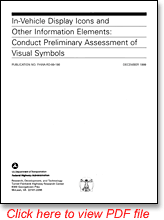In-Vehicle Display Icons and Other Information Elements: Preliminary Assessment of Visual Symbols
IN–VEHICLE DISPLAY ICONS AND OTHER INFORMATION ELEMENTS
PRELIMINARY ASSESSMENT OF VISUAL SYMBOLS
FOREWORD
This is one of a series of reports produced as part of a contract to develop precise and detailed human factors design guidelines for in–vehicle display icons and other information elements. The contractual effort consists of three phases: analytical, empirical, and integrative.
This report is the second product of the analytical phase. It provides design guidance for the joint use of visual, auditory, and tactile information presentation and builds a foundation for future design tools that will assist designers in specifying icon design for in–vehicle information technologies, particularly as they relate to Advanced Traveler Information Systems (ATIS).
Copies of this report can be obtained through the Research and Technology Report Center, 9701 Philadelphia Court, Unit Q, Lanham, Maryland 20706, telephone: (301) 577–0818, fax: (301) 577–1421, or the National Technical Information Service (NTIS), 5285 Port Royal Road, Springfield, Virginia 22161, telephone: (703) 605–6000, fax: (703) 605–6900.
Michael F. Trentacoste
Director, Office of Safety
Research and Development

PDF Version (679 KB)
PDF files can be viewed with the Acrobat® Reader®
TECHNICAL REPORT DOCUMENTATION PAGE
| 1. Report No. FHWA–RD–99–196
|
2. Government Accession No. |
3. Recipient's Catalog No. |
| 4. Title and Subtitle
IN–VEHICLE DISPLAY ICONS AND OTHER INFORMATION ELEMENTS: CONDUCT PRELIMINARY ASSESSMENT OF VISUAL SYMBOLS
|
5. Report Date December, 1999 |
| 6. Performing Organization Code |
| 7. Author(s) John D. Lee, Cher Carney, Steven M. Casey, and John L. Campbell |
8. Performing Organization Report No. |
| 9. Performing Organization Name and Address
Battelle Human Factors Transportation Center
4000 NE 41st Street
Seattle, WA 98105
|
10. Work Unit No. (TRAIS) |
| 11. Contract or Grant No. DTFH61–97–R–00061 |
| 12. Sponsoring Agency Name and Address
Office of Safety and Traffic Operations R&D
Federal Highway Administration
6300 Georgetown Pike
McLean, VA 22101–2296
|
13. Type of Report and Period Covered
Preliminary Assessment of Visual Symbols
12/97 – 6/98
|
| 14. Sponsoring Agency Code |
| 15. Supplementary Notes Contracting Officer's Technical Representative (COTR): Thomas Granda, HRDS |
| 16. Abstract
This report describes the methods and results associated with Task B: Preliminary Assessment of Visual Symbols. The purpose of Task B is
twofold: (1) it identifies credible procedures, heuristics, and principles for the joint use of visual, auditory, and tactile information to present
in–vehicle messages, and (2) it defines message characteristics that should guide symbol design. Defining these characteristics and
their interactions helps to identify design tradeoffs and provides the basis for future design guidelines and tools. The methodology employed to
complete Task B included: refining a list of previously generated IVIS messages, conducting a review of the literature relevant to sensory modality,
evaluating the IVIS messages using a sensory modality decision tool, defining messages according to their contextual characteristics and information
processing elements (IPEs), clustering messages according to their contextual characteristics, grouping those clusters to identify general design
categories, and examining the IPEs and design tradeoffs within each cluster and category.
Through the process of devising these design tools and decision aids and analyzing the list of relevant IVIS messages, we developed the following
conclusions: (1) a review of existing literature regarding visual, auditory and tactile information presentation provided numerous general principles
for modality selection, which was the basis for an effective sensory modality decision tool, (2) classifying IVIS messages according to ITS
technologies and general functions is insufficient for providing effective design guidelines, (3) understanding the driving context under which
IVIS messages are presented is critical for successful design guideline development, (4) the IPEs associated with an IVIS message can successfully be
used to develop the design guidelines that consider the perceptual, memory, and motor control limits of the driver, (5) the cluster analysis technique
provides a powerful tool to focus future analyses on a meaningful subset of possible combinations of contextual characteristics and IPEs, (6)
the tools and decision aids developed as part of Task B have provided the project team with a solid analytical foundation to begin guideline
development in Task C of this project, and (7) a key challenge associated with Task C will be to integrate the information provided in this report
and develop clear, relevant, and easy–to–use design guidelines for in–vehicle icons.
|
| 17. Key Words Human Factors, In–Vehicle Icons, ITS, Display Modality, Driver Information |
18. Distribution Statement
No restrictions. This document is available to the public through the National Technical Information Service, Springfield, VA 22161.
|
| 19. Security Classif. (of this report) Unclassified |
20. Security Classif. (of this page) Unclassified |
21. No. of Pages 196 |
22. Price |
Form DOT F 1700.7 (8–72) Reproduction of completed page authorized
FHWA-RD-99-196
|
